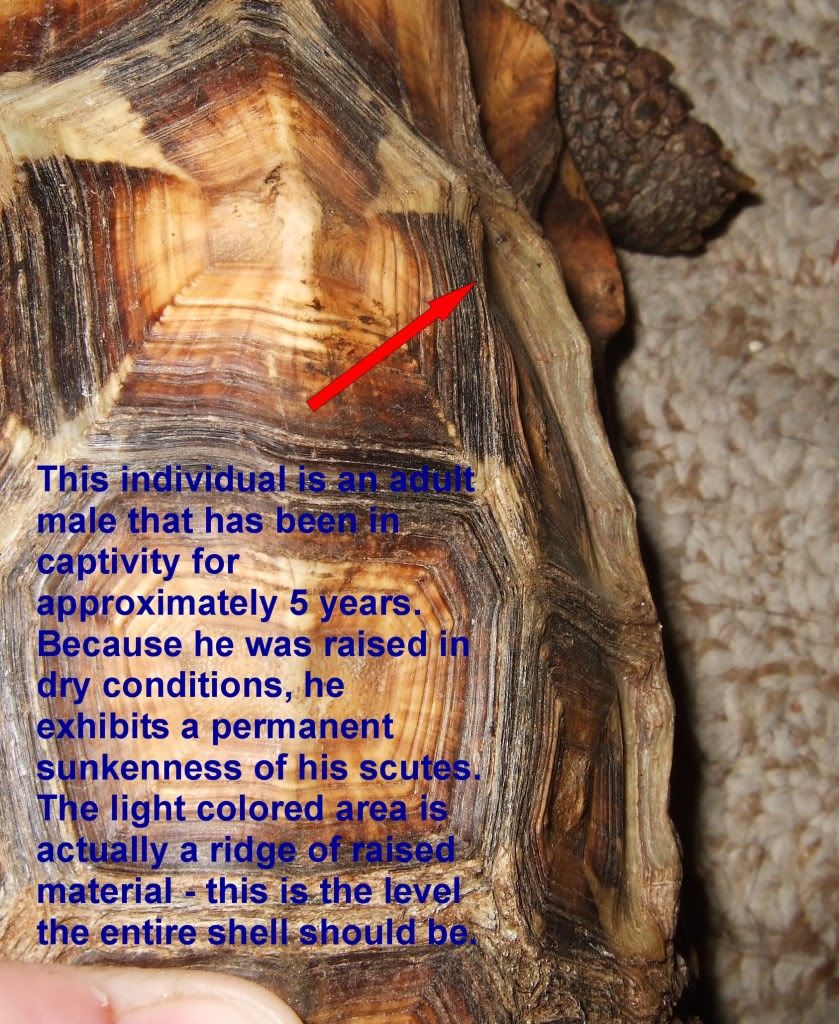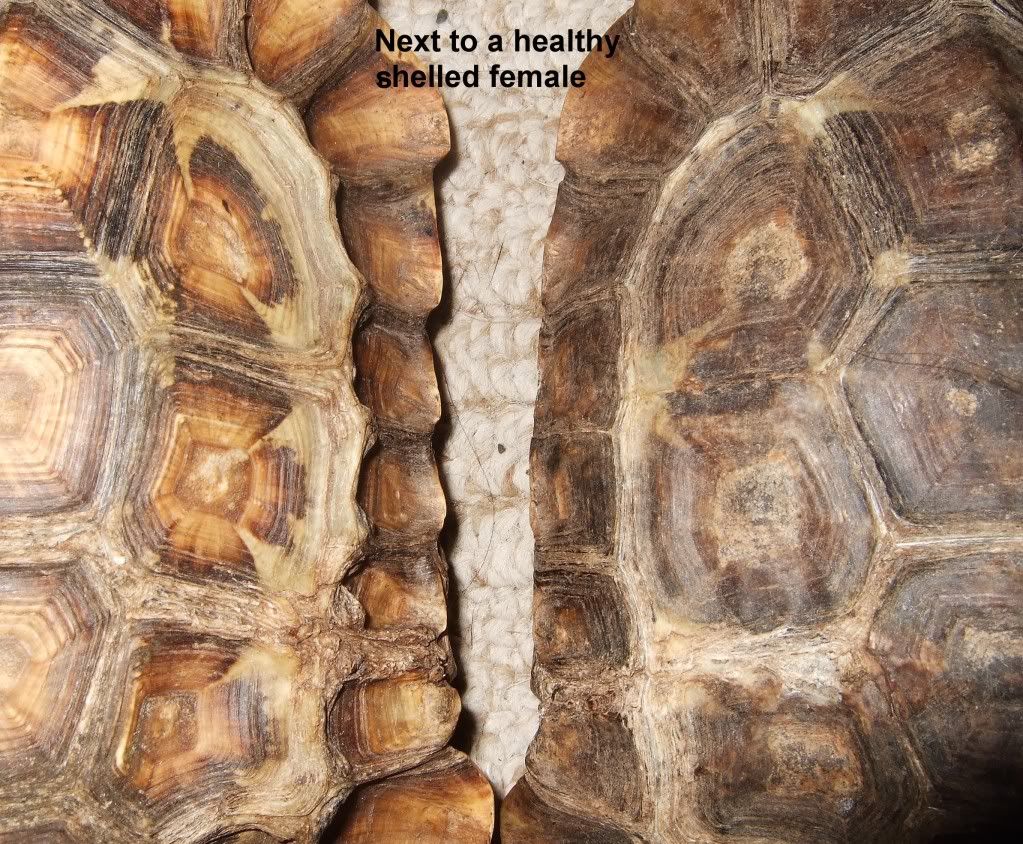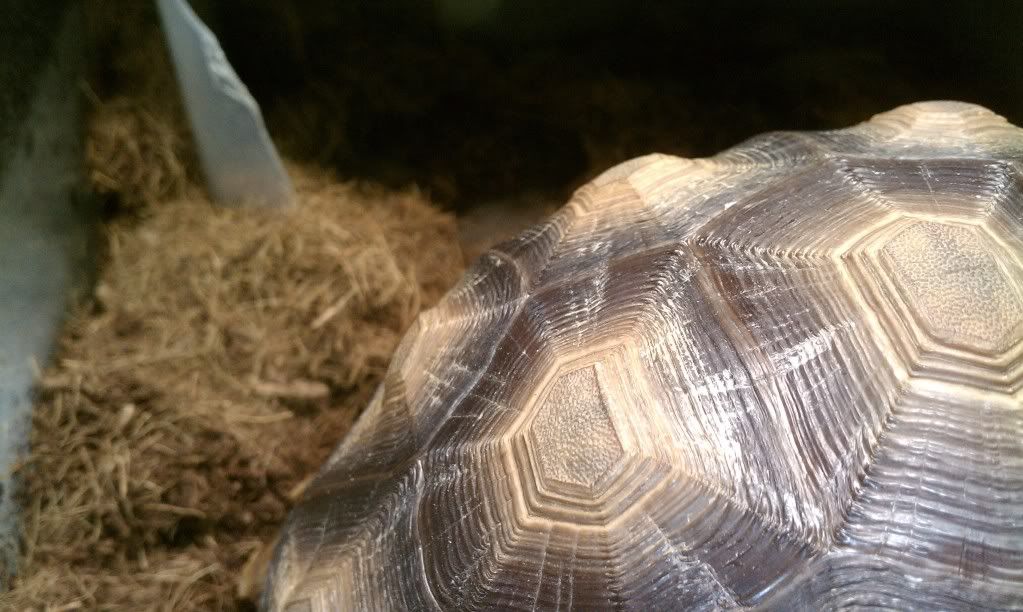For the past year I have raised my tortoise using the "wet method". The original pyramiding remains, but I have had sustained smooth growth. Recently I have noticed that the area along the new growth line of some of the scutes is raised, or the areola area is depressed. I can't decide which it is. Some time ago while reading everything I could on pyramiding and it's prevention I ran across the term "reverse pyramiding". Could this be what is happening?
You are using an out of date browser. It may not display this or other websites correctly.
You should upgrade or use an alternative browser.
You should upgrade or use an alternative browser.
Reverse pyramiding?
- Thread starter Dizisdalife
- Start date
- Status
- Not open for further replies.
We need a pic Joe.
I knew you would ask for one and I really don't have a good picture that focuses on that part of the shell. Here is one that might show what I am talking about. I can take more tomorrow.


The term "reverse pyramiding" typically refers to species such as Redfoots, Yellowfoots, Hingebacks, and Manouria. Reverse pyramiding results from the tortoise being kept too dry. In tortoises such as Sulcatas, Greeks, Desert tortoises and other "grassland" species, being kept too dry results in pyramiding, or the scutes growing in a stacked "pyramid" shape.
In "forest" tortoises, being kept too dry results in the scutes shrinking downward. Because the tortoise is deyhdrated, the scutes almost shrivel downward, loosing the plump, rounded appearance. If the dehydration is chronic, the shell continues to grow this way.
Here is a picture of one of my Home's Hingebacks with reverse pyramiding. Let me also point out that when a tortoise is very young, by increasing the humidity and internal hydration this can be corrected. I purchased this male as a long term captive adult, and the damage done by his previous owner is permanent. He was kept running free in a bedroom with no humidity control. His reverse pyramiding is so severe that his scutes are sunken my more than a 1/4 of an inch.


See how the coastal scutes have an almost "scooped out" appearance? That is reverse pyramiding.
When a tortoise grows, new scute material is laid down both under and in between existing scute material. This can cause gapping or ridging at the growth line. In the wild, the rings in a tortoise's shell show "seasons" in a way, or periods of hot/dry/slow growth and periods of wet/faster growth. These slight ridges and lines are perfectly normal. As tortoises age, they tend to wear them somewhat smooth, especially wild tortoises or tortoises raised outside.
Frankly, your tortoise is beautiful. I see nothing what so ever that suggests any reverse pyramiding. Keep up the good work!
In "forest" tortoises, being kept too dry results in the scutes shrinking downward. Because the tortoise is deyhdrated, the scutes almost shrivel downward, loosing the plump, rounded appearance. If the dehydration is chronic, the shell continues to grow this way.
Here is a picture of one of my Home's Hingebacks with reverse pyramiding. Let me also point out that when a tortoise is very young, by increasing the humidity and internal hydration this can be corrected. I purchased this male as a long term captive adult, and the damage done by his previous owner is permanent. He was kept running free in a bedroom with no humidity control. His reverse pyramiding is so severe that his scutes are sunken my more than a 1/4 of an inch.


See how the coastal scutes have an almost "scooped out" appearance? That is reverse pyramiding.
When a tortoise grows, new scute material is laid down both under and in between existing scute material. This can cause gapping or ridging at the growth line. In the wild, the rings in a tortoise's shell show "seasons" in a way, or periods of hot/dry/slow growth and periods of wet/faster growth. These slight ridges and lines are perfectly normal. As tortoises age, they tend to wear them somewhat smooth, especially wild tortoises or tortoises raised outside.
Frankly, your tortoise is beautiful. I see nothing what so ever that suggests any reverse pyramiding. Keep up the good work!
Thanks Kristina. I am probably worrying about nothing. It has given me the opportunity to learn a little more about raising tortoises. Here are a few pictures taken this morning while he soaked. What I have been concerned about just does not show up as pronounced in pictures as it does in person.
In some spots it feels as though a ridge has formed near the new growth line. Since I have not seen this happening before now I was concerned. Chuck, the tortoise, is almost 2 years old. I have had him about 14 months. He has grown from 2.5 inches and 100 grams to about 7.75 inches and 1650 grams.
In the photos you can see the original pyramiding and the growth since I begin keeping him warm and wet. What a difference it has made.



In some spots it feels as though a ridge has formed near the new growth line. Since I have not seen this happening before now I was concerned. Chuck, the tortoise, is almost 2 years old. I have had him about 14 months. He has grown from 2.5 inches and 100 grams to about 7.75 inches and 1650 grams.
In the photos you can see the original pyramiding and the growth since I begin keeping him warm and wet. What a difference it has made.



that looks like normal scutes growing together to me. WalkingRock has a couple of places like that, I just thought it was the way the scutes where pushing on each other.
Kristina said:The term "reverse pyramiding" typically refers to species such as Redfoots, Yellowfoots, Hingebacks, and Manouria. Reverse pyramiding results from the tortoise being kept too dry. In tortoises such as Sulcatas, Greeks, Desert tortoises and other "grassland" species, being kept too dry results in pyramiding, or the scutes growing in a stacked "pyramid" shape.
In "forest" tortoises, being kept too dry results in the scutes shrinking downward. Because the tortoise is deyhdrated, the scutes almost shrivel downward, loosing the plump, rounded appearance. If the dehydration is chronic, the shell continues to grow this way.
When a tortoise grows, new scute material is laid down both under and in between existing scute material. This can cause gapping or ridging at the growth line. In the wild, the rings in a tortoise's shell show "seasons" in a way, or periods of hot/dry/slow growth and periods of wet/faster growth. These slight ridges and lines are perfectly normal. As tortoises age, they tend to wear them somewhat smooth, especially wild tortoises or tortoises raised outside.
The other day, I came across a Russian tortoise at a pet store (apparently an LTC, judging by the "two-tone" growth rings), and he had what I would call reverse pyramiding. How would an arid/semi-arid species develop reverse pyramiding in captivity?
- Status
- Not open for further replies.
Similar threads
- Replies
- 7
- Views
- 17K
- Replies
- 48
- Views
- 8K
New Posts
-
-
Setting up for a Russian Tortoise - Constructive comments welcome
- Latest: _The_Beast_
-
-
-